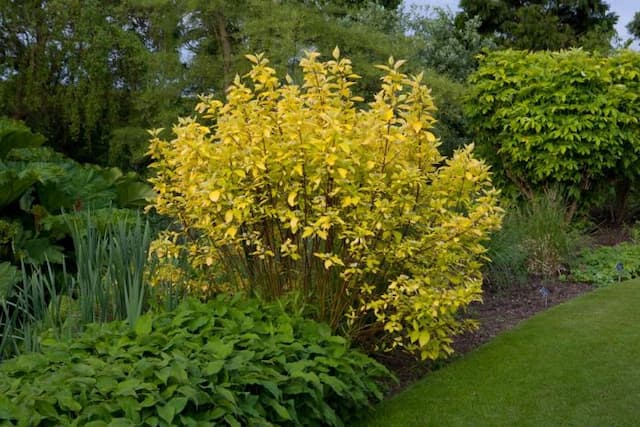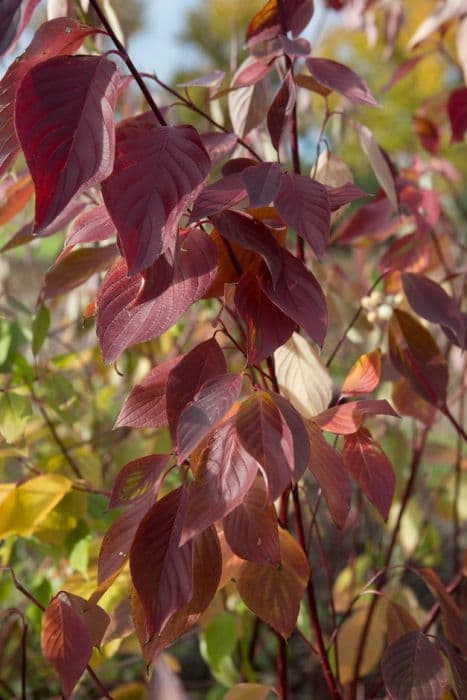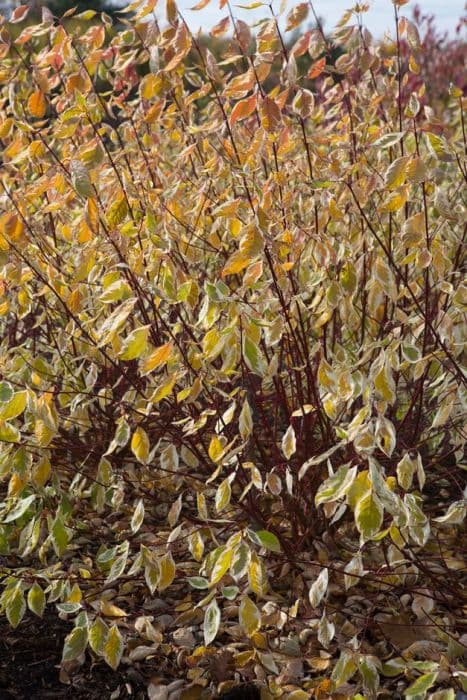Chinese Dogwood Cornus kousa var. chinensis 'Wisley Queen'











ABOUT
The 'Wisley Queen' is a striking variety of Kousa dogwood known for its decorative and showy features. This plant typically blooms in late spring to early summer, presenting a beautiful display of star-shaped flowers that capture the eye. Each flower consists of four large, creamy white bracts which surround the small, inconspicuous central cluster of yellowish-green true flowers. As the season progresses, the flowers gradually transition into raspberry-like fruit that adds to the ornamental appeal of the plant. The fruit is a deep pinkish-red and is not only attractive but also edible, though it's more commonly admired for its visual interest than eaten. The foliage of the 'Wisley Queen' is also noteworthy, with leaves that are lush and a vibrant green color. In autumn, these leaves transform, showcasing a spectacular autumn coloration that ranges from reddish-purple to striking scarlets, often with touches of pink or orange, before they eventually fall off. The bark of the 'Wisley Queen' is another distinctive feature, peeling off in patches to reveal an interesting mosaic of colors on the underlying surface, including shades of brown and gray, which provides year-round visual interest even after the leaves have dropped. Overall, the 'Wisley Queen' Kousa dogwood is prized for its multi-season appeal, highlighted by its showy bracts, attractive fruit, stunning autumn foliage, and exfoliating bark. It is a favored choice for gardeners looking to add a standout specimen to their landscape.
About this plant
 Names
NamesSynonyms
Chinese Dogwood, Kousa Dogwood, Korean Dogwood, Japanese Dogwood, Asian Dogwood.
Common names
Cornus kousa var. chinensis 'Wisley Queen'.
 Toxicity
ToxicityTo humans
Chinese dogwood 'Wisley Queen' is generally not considered toxic to humans. In fact, the fruit of the Chinese dogwood is sometimes eaten in small quantities when ripe and is used in some traditional culinary applications. However, all plant parts should be consumed with caution, as the unripened fruit, leaves, and other parts have not been widely studied for their effects when ingested. If an individual has a sensitive stomach or any allergies, it is always best to avoid eating ornamental plants due to the possibility of gastrointestinal discomfort or an allergic reaction.
To pets
Chinese dogwood 'Wisley Queen' is not known to be toxic to pets, such as dogs and cats. This means that it is generally safe for pets, but consumption of any plant material can potentially cause mild stomach upset in some animals. If a pet consumes a large amount of the plant, or if your pet has a particular sensitivity, they may experience symptoms such as vomiting or diarrhea. If any such symptoms occur or if there is a concern about the quantity ingested, it is advisable to contact a veterinarian.
 Characteristics
CharacteristicsLife cycle
Perennials
Foliage type
Deciduous
Color of leaves
Green
Flower color
White
Height
15-20 feet (4.5-6 meters)
Spread
15-20 feet (4.5-6 meters)
Plant type
Tree
Hardiness zones
5-8
Native area
China
Benefits
 General Benefits
General Benefits- Ornamental Appeal: Produces large, showy white bracts in early summer, adding visual interest to gardens.
- Drought Tolerance: Once established, it is relatively drought resistant, requiring minimal watering.
- Pest Resistance: Generally resistant to many common pests, reducing the need for chemical treatments.
- Wildlife Attraction: Flowers provide nectar for pollinators, while the fruit attracts birds and other wildlife.
- Seasonal Interest: Offers year-round interest with flowers in spring, fruit in summer and fall, and exfoliating bark in winter.
- Edible Fruit: Produces berry-like fruit that is edible and can be used in jams and baking.
- Adaptability: Adapts well to a range of soil types, although it prefers well-drained, fertile soil.
- Compact Size: It's a compact cultivar suitable for smaller gardens or limited spaces.
- Fall Color: Leaves turn to vibrant shades of red and purple in autumn, enhancing the plants' seasonal beauty.
 Medical Properties
Medical Properties- This plant is not used for medical purposes.
 Air-purifying Qualities
Air-purifying QualitiesThis plant is not specifically known for air purifying qualities.
 Other Uses
Other Uses- Edible Fruits: The fruits of Kousa dogwood can be eaten fresh, made into jams or used in desserts, providing a mild, sweet flavor with a slightly tropical taste.
- Wildlife Habitat: Kousa dogwood provides shelter and nesting sites for birds and other small wildlife within its dense canopy.
- Dye Production: The bark and leaves of Kousa dogwood can be used to produce dyes for textiles in shades of brown and green.
- Photography Prop: With its striking floral display, Kousa dogwood is often used as a backdrop or subject in landscape and botanical photography.
- Cultural Symbolism: In some cultures, the Kousa dogwood is a symbol of purity and resilience, and can be used in cultural ceremonies and artwork.
- Woodwork: The wood of the Kousa dogwood is hard and dense, making it suitable for small woodworking projects like carving or tool handles.
- Ink Production: The fruit has historically been used to make a type of ink or as a colorant for art projects.
- Bonsai Specimen: Kousa dogwood, with its striking appearance and slow growth, can be trained as a bonsai specimen, admired for its beauty and form.
- Education and Research: This plant serves as a subject for botanical studies and educational programs focusing on tree physiology, ecology, and horticulture.
- Winter Interest: The exfoliating bark and winter silhouette of Kousa dogwood provide visual interest in the garden during the dormant season.
Interesting Facts
 Feng Shui
Feng ShuiThe Kousa Dogwood is not used in Feng Shui practice.
 Zodiac Sign Compitability
Zodiac Sign CompitabilityThe Kousa Dogwood is not used in astrology practice.
 Plant Symbolism
Plant Symbolism- Protection: The Cornus kousa variety, commonly known as Kousa dogwood, often symbolizes safety and protection because of its sturdy wood and resilient nature.
- Endurance: This plant is known for its ability to withstand challenging conditions, representing strength and the ability to endure life's hardships.
- Purity: The Kousa dogwood's pristine white blooms are often associated with purity and innocence.
- Love and Affection: In the language of flowers, dogwoods can represent affection and the longing for love's return.
- Christian Symbolism: In Christian symbolism, the dogwood is said to be associated with the crucifixion of Christ, with its flower's cross shape representing the crucifixion, and the red stigmas the wounds of Christ.
- Renewal: Blooming in late spring, the dogwood is often seen as a symbol of new beginnings and the rebirth that comes with the season.
 Water
WaterThe Kousa Dogwood (Cornus kousa var. chinensis 'Wisley Queen') should be watered deeply once a week, providing approximately 1 to 2 inches of water each time, which translates to about 0.62 to 1.25 gallons for a small to medium-sized tree. Consistency is crucial during the first growing season to establish a deep, extensive root system. In the absence of rainfall, continue the weekly watering, ensuring the soil is moist but not saturated. Reduce watering frequency to every two to three weeks during the cooler months or in well-established plants, always adjusting for rainfall and current weather conditions.
 Light
LightKousa Dogwood prefers a spot that offers full sun to partial shade. The ideal location would receive unfiltered sunlight for at least 4 to 6 hours a day, while also providing protection from the intense afternoon sun, particularly in hotter climates. Morning sun with dappled afternoon shade can prevent leaf scorch and promote healthy blooming and growth.
 Temperature
TemperatureKousa Dogwood thrives in a range of temperatures and is hardy in USDA zones 5 through 8. It can handle a minimum temperature of around -20°F and a maximum of 90°F. Ideal growing conditions are between 60°F and 75°F, as extremes of heat or cold can stress the plant.
 Pruning
PruningPrune Kousa Dogwood to maintain shape and remove any dead or diseased branches. The best time to prune is late winter or early spring before the tree displays new growth. Pruning every 2 to 3 years is often sufficient, focusing on thinning the crown to allow light and air circulation, which helps prevent disease.
 Cleaning
CleaningAs needed
 Soil
SoilThe Kousa Dogwood 'Wisley Queen' thrives in a well-draining soil mix which ideally consists of loamy or sandy composition with added organic matter. The best pH range for this plant is slightly acidic to neutral, falling between 5.5 to 7.0. Consider incorporating peat moss, compost, and pine bark into the soil mix for optimal growth.
 Repotting
RepottingThe Kousa Dogwood 'Wisley Queen' does not need frequent repotting; it should be done every 2 to 3 years, or when the root system outgrows its current container. Repotting in the spring allows the plant to establish in its new pot during the growing season.
 Humidity & Misting
Humidity & MistingKousa Dogwood 'Wisley Queen' prefers moderate humidity levels typical of outdoor environments. While specific humidity levels are not crucial, maintain ambient moisture without excessive dampness to support healthy growth.
 Suitable locations
Suitable locationsIndoor
Ensure bright, indirect light and well-drained soil.
Outdoor
Plant in full sun to partial shade, in moist soil.
Hardiness zone
5-8 USDA
 Life cycle
Life cycleCornus kousa var. chinensis 'Wisley Queen', commonly known as Chinese dogwood 'Wisley Queen', begins its life as a seed which after stratification in cold temperatures germinates in spring. It develops into a seedling, with the first set of true leaves emerging to start photosynthesis. As a juvenile, the plant experiences rapid growth for several years until reaching maturity, where it forms a distinctive vase-shaped to rounded crown with layers of branches. The mature plant blooms in late spring to early summer, featuring showy, large white flower bracts followed by red, berry-like fruits which are attractive to birds. Every growing season, the Chinese dogwood 'Wisley Queen' adds new growth in branches and foliage, and maintenance of its shape may involve periodic pruning. The plant continues this cycle annually, focusing energy on flowering and seed production, until it reaches old age, with its lifespan potentially extending up to 50 years or more under optimal conditions.
 Propogation
PropogationPropogation time
Late winter to early spring
The most popular method for propagating the Chinese dogwood 'Wisley Queen' is through softwood cuttings. This technique is typically carried out in late spring to early summer, when new growth is mature enough yet still pliable. Cuttings should be about 4 to 6 inches (10 to 15 centimeters) long and taken from the current year's growth. Cut just below a node and remove the lower leaves to expose a couple of nodes where the roots will form. It's beneficial to dip the cut end into a rooting hormone to increase the chances of successful rooting. After preparation, the cuttings are planted in a well-draining rooting medium and kept under high humidity and indirect light until roots develop, which usually takes several weeks.

![Dogwood [Baton Rouge]](/_next/image?url=https%3A%2F%2Fplants-admin.emdemapps.com%2Fimages%2Fplants%2F%2Fimages%2F604b59cf0fefd.png&w=640&q=75)


![Dogwood [Ivory Halo]](/_next/image?url=https%3A%2F%2Fplants-admin.emdemapps.com%2Fimages%2Fplants%2F%2Fimages%2F604b535cbcb9a.png&w=640&q=75)




